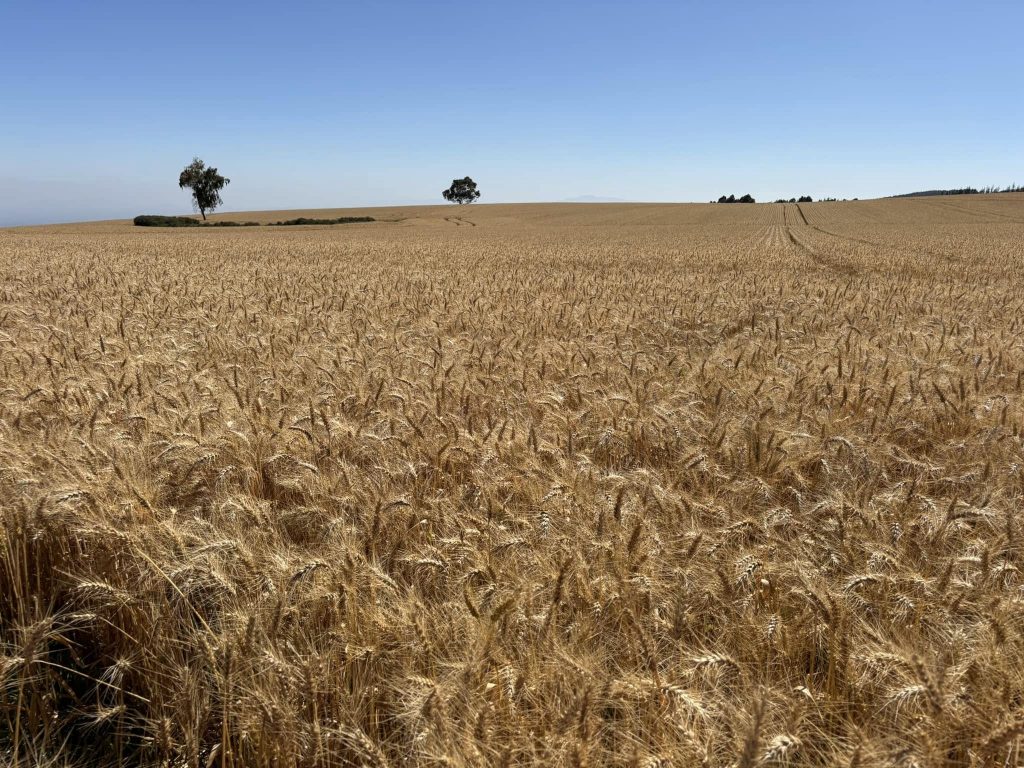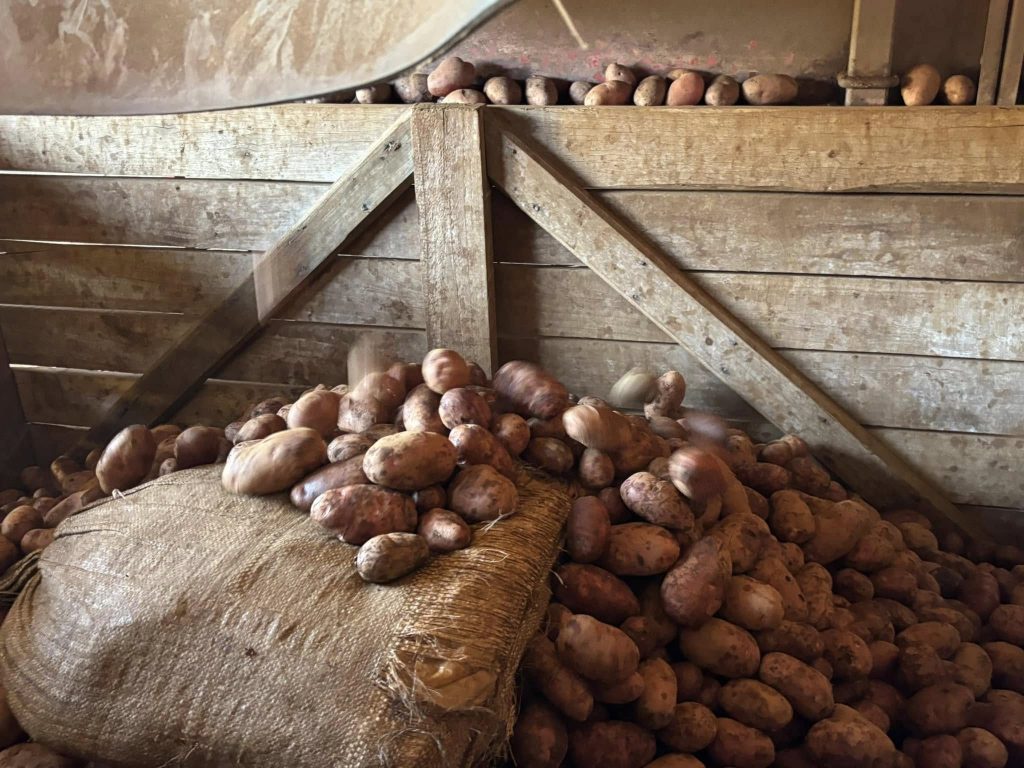
Class XXI of the OALP started early and kept working well after dinner on Thursday as their Kenya travel experience continued. Dr. Edmond Bonjour offers us his thoughts at each of the stops:
The first farm visit today for the OALP was to Kisima Farm on the slopes of Mount Kenya at 2,800 meters Kisima is an extensive, highly productive, mixed working farm in Timau, Meru County. Founded in 1919, and incorporated in 1943, the agribusiness is 100% Kenyan owned and operated, with 26 shareholders. While arable crops and floriculture are the primary focus, Kisima also manages a successful forestry program and supports numerous thriving community development projects. Buzz shared that they farm 2,000 hectares in total, but plant twice per year in two seasons where they plant about 1,400 acres in each. They use a four-way rotation of wheat, canola, barley, and peas. Other crops include sunflowers, lupines, buckwheat, and rape. Their main income is from wheat and barley. They were going to start planting barley today with a 9-meter direct drill planter using 7.5 inch spacing at a variable rate (they talk in both imperial and metric units). Their grain storage facility holds 3,000 tons and they produce 5,000 tons annually. About 25 people work in the cleaning shed. Barley seed goes to brewers and wheat goes to millers. They keep their own seeds for planting which is done mainly in April and September. They plant two varieties of wheat in September at a rate of 90-130 kg per hectare. Their typical yield is 80 bushels per acre and they use two Claas combines for harvest. Rust is found year-round so they are looking at planting variety mixes to minimize this disease. They also have an experimental area where CIMMYT has 7,000 variety trials.

Kisima also grows seed potatoes in two seasons – harvesting now and planting in March. They plant 100 hectares per season. Forestry is part of their diversified growing strategy and they grow eucalyptus, pine, and cypress trees. Eucalyptus is used for fuel and fence posts. They employ 200-220 people of which 90 are for security – mainly petty theft of crops directly from the fields which are then used to feed their families or to sell at markets. They advertised for five jobs and 300 people showed up so they put all their IDs in a bucket and then drew out five. Those five had to meet minimum qualifications. For community development they have a Farm Foundation which feeds 6,000 children in 26 schools. They also give stone-ground brown flour to the schools.
Next – The OALP toured Uhuru Flowers, which was founded in 2007. It comprises seven acres of greenhouses where about 70 varieties of cut roses are grown by 350 employees. The big green houses are 100 x 300 meters. They pick twice daily every day of the week. Our group first visited the area where Damascus rose petals are distilled into rose water and rose oil. One container of petals weighs 200 pounds and will produce about 10 liters of rose water and a little oil. They process two containers daily. Rose water sells for $8-10 per liter, whereas rose oil sells for $8-10,000 per liter and is usually sold by the gram for export. This rose is supposedly the one in the crown of thorns of Jesus. Rose beds in the greenhouse last about 10 years. About 80% of the water utilized for growing is from roof runoff. Most of their roses are grown specifically for length and big heads. Every additional 10 cm adds increased income. After they are planted, the first rose will be harvested in three months. They average 90 heads per square meter, but the best varieties produce 220 heads per square meter. After they are cut, roses are placed in a cold room at 3 degrees Centigrade within 15-20 minutes, and then cooled farther to 1 degree Centigrade for storage. From the time they are cut until they are at international markets is four days. During processing, they are sorted by size and quality. A standard shipping box holds 260 rose stems.





The third farm of the day was Tambuzi Farms which are specialists in the production of traditional scented garden roses, in addition to spray roses which have 3-5 heads per stem, and alstroemeria. They grow eight types of spray roses. Soil health is extremely important so they use compost, a bio-slurry, and frass (insect poop) to improve the soil. They plan to be organic in three years. The farm has three hectares of alstroemeria in greenhouses and they use heavy mulch to keep the soil moist and cool.





The fourth tour for the OALP today was to Turaco Farm that raises pigs for meat. Pigs arrive to the farm at 10-weeks old, fed milk starter for four weeks, and then fed a grower formulation, which has less protein, until they are 40-weeks old and ready for slaughter. They are housed 10 pigs per paddock and are moved every five days to a new paddock. There are 50 paddocks. Pigs are slaughtered when they weigh 60-65 kg. We then learned about their Black Soldier Fly Project which converts organic waste into fertilizer and animal protein. Black soldier flies (BSF) live seven days and are housed in a net-covered “love cage” to produce eggs. Eggs are layed on a medium referred to as eggies. Eggies are placed over pungent decomposing material in which the female lays eggs. Eggies are collected daily and placed in hatching containers filled with a high quality food source. Much of the food is made from waste vegetables. Once the eggs hatch, the larvae are raised in a controlled environment with adequate food, moisture, and temperature to support their growth and development. When larger, the larvae are reared in outside trays. When mature at fifth instar, they then pupate. The pupae (45% protein) are either processed for feeding to animals such as the pigs, or put in the dark room behind the love cage to become adults and start the life cycle over.





After dinner, we had two special speakers that were not part of our agenda. Tracy Bunch, Special Agent in Charge/Attache Force Protection Detachment, and Mathew Kimokiy, Security Specialist, both with the Department of Defense with the Embassy of the United States of America in Nairobi, Kenya, are staying at the same hotel as the OALP. Tracy shared that he is here for counterterrorism and security support for the U.S. military in Kenya. There is active terrorism in the northern counties near Ethiopia and Somalia, not anywhere near where we are touring, and livestock thefts north of here. They work closely with the Anti-terrorism police and the Kenya Wildlife police. Mathew specializes in seamless interactions with multinationals. He also enjoys bringing together agencies and building relationships between leaders of Kenya and the U.S.
Jambo means hello in Swahili.





















